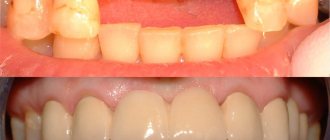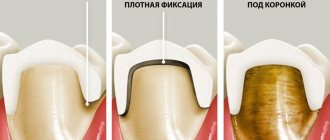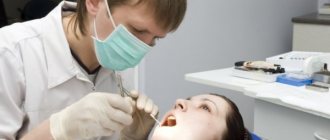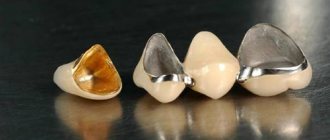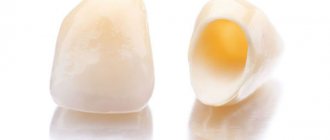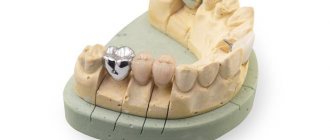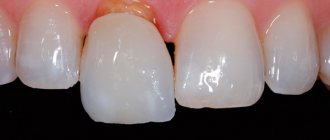A metal-ceramic prosthesis is a metal frame on which a layer of ceramic is placed. It is carefully dried in a special oven at a certain temperature, then polished and installed for the patient.
The complexity of the procedure for restoring a crack or chip that has formed for a dentist is as follows:
- restoration is carried out not with a ceramic solution, but with a composite material, the properties of which imply that the frame is translucent. Which negatively affects aesthetic indicators. This is especially critical if the chip occurred on the teeth of the “smile zone”;
- the doctor must select the appropriate shade of the restoration mixture as accurately as possible so that it does not differ in color from ceramics;
- While the prosthesis is made in the laboratory, its restoration has to be done in the patient’s mouth, which is associated with many difficulties for both the client and the dentist.
Description of material
A metal-ceramic crown is made from a metal alloy and then covered with porcelain. In this case, the frame can be made of several noble metals at the same time or simply of cobalt, nickel, chromium. It is these materials that provide the structure with the necessary strength, so the tooth and jaw as a whole can function normally. The ceramic layer is responsible for aesthetics.
Replacing teeth with ceramics is considered one of the most reliable and durable options. But, as a rule, they are the ones most often exposed to chips and various damages. Therefore, you need to know what to do if a piece of a metal-ceramic crown breaks off. The fact is that ignoring this problem can destroy it completely in a short time.
This is especially true for those people who do not follow medical recommendations and consume solid foods. Such abuse often violates the integrity of the tooth: first, microcracks form on it, and later chips appear.
Prevention of cracks in crown enamel
The best preventive measures are a balanced diet and careful treatment of your teeth. You should not eat hot and cold foods at the same time. This alternation leads to cracking of the enamel.
To maintain dental health, it is recommended to take dietary supplements. For example, a complex of calcium citrate and vitamin D. When brushing your teeth, you should give preference to medium-hard brushes and non-abrasive pastes. After eating, it is advisable to use dental floss.
To preserve your dental health, you need to undergo a preventive examination at the clinic twice a year and listen to the recommendations of dentists.
Main causes of damage
A ceramic crown can become damaged for various reasons. But, as dental technicians note, the most common cases of chipping are as follows:
- A man has bruxism, and the dentist who performed the prosthetics did not ask about the disease.
- The patient does not comply with the operating instructions.
- The product may chip due to a foreign body that has entered the space between the tooth and the crown.
- When manufacturing the device, the master did not take into account the composition’s ability to thermally expand.
- There are too many dental units in the bridge, so it bears a heavy load of both external and internal nature.
- The shape of the prosthesis is incorrect or poorly made, so the pressure on it from the opposite jaw row is uneven.
- The technology during firing of the structure was violated.
- The preparation was not performed correctly, the taper of the crown is incomplete, which causes severe stress within the system.
- During the restoration, an excessively thick fixing cement mixture was used.
During the operation of the crown, a chip appeared
After the recovery procedure
Treatment Options
An experienced dentist will offer the client several options to get out of this situation:
- if the damage is not visible when talking or smiling, the edges of the chip can simply be polished;
- replace the prosthesis: the most correct, although far from the cheapest, option. Will require a lot of time and patience;
- restoration of the crown of an artificial tooth without removing the prosthesis directly in the patient’s mouth. This option is most often practiced in domestic dental clinics.
Restoring a ceramic coating in the laboratory on a previously removed tooth is very often impossible due to severe damage to the prosthesis during its removal.
Modern methods of restoration
A chip in the ceramic mass does not look very attractive. The patient’s quality of life decreases and various complexes appear. Modern dentistry offers several ways to restore teeth; there are even options in which you can sharpen a metal-ceramic crown without removing it.
The most common restoration method is polishing. The procedure is performed for minor damage to the ceramic part of the tooth. The main disadvantage of this method is that the crown loses its original shape, so it is most often used if the chip is in an inconspicuous place.
One of the main advantages of polishing is accessibility, since the cost of such procedures is low. During the event, the doctor treats the damaged area with a special polishing compound using a rubber brush, and the gaps between the teeth with finishing plates.
Repairing a chip on a metal-ceramic crown involves completely replacing it. This option is the most expensive of all, but also the most reliable. If the structure was screwed in, then it is drilled out with a special drill and a suitable nozzle. If the crown was fixed with dental glue, then preliminary decementing is required: a softener is applied, which will bring the glue to a paste-like state.
After the structure has been cemented, the dentist makes a control impression, prepares the tooth, if necessary, and then performs processing. Next, the model is sent to the laboratory for the manufacture of a new product. The effectiveness of this method cannot be compared with any other correction option in terms of efficiency and effectiveness.
The next restoration is carried out only after the crown is removed, but it should immediately be noted that this option has many disadvantages, so doctors do not recommend using it. This is due to the fact that it is extremely difficult to maintain the integrity of a ceramic tooth if it is fixed with cement. Although there are patients who agree to this procedure because of the low cost and short repair time.
There are more progressive and gentle methods for restoring a chipped tooth that do not destroy ceramics. Such dental procedures involve the use of directional ultrasonic vibrations, as well as the supply of compressed air. But such procedures are carried out only in good clinics that are equipped with expensive devices.
Repairs can also be made directly in the oral cavity. As a rule, such restoration leaves virtually no traces behind. Modern composites are of very high quality; after spraying, the metal does not show through.
A significant disadvantage of the procedure: no doctor can guarantee that the crown will last a long time and will not fall off immediately. Such manipulations are somewhat reminiscent of ordinary fillings.
A longitudinal (vertical) crack appeared on the tooth
Shallow cracks along the tooth that do not extend under the gums are eliminated with a composite material and subsequent installation of veneers. Thin overlays mask the aesthetic defect and strengthen the crown, preventing its further destruction. Molars experience increased chewing load, so cracks on them require the use of ceramic/zirconium crowns.
A deep vertical crack often leads to pulpitis. In this case, it is necessary to remove the nerve and carry out a step-by-step reconstruction of the tooth (filling, veneer or crown).
With a strong impact, a vertical crack extends to the root of the tooth. It is possible to restore a tooth if the root is at least one third intact, and the patient immediately seeks help. An attempt to save a dead tooth in this way with partial damage to a single root (incisors, canines and sometimes premolars) often leads to the gradual destruction of the entire root system. In such cases, the only correct option is tooth extraction and subsequent prosthetics/implantation.
Important! Since a pulpless tooth does not receive nutrition, the enamel quickly loses its strength. Therefore, it is advisable to install a crown on a cracked tooth without a nerve (the root is not damaged).
Horizontal tooth crack
A crack surrounding a tooth often does not affect the pulp, so the nerve can be preserved. Tooth restoration includes the use of a composite and restoration with crowns or veneers (front only). Without timely treatment, a transverse crack leads to partial chipping of the tooth. The dentist builds up the broken area with a composite material.
A high risk of tooth loss is caused by a horizontal crack formed at the gum line. In this place the tooth is most vulnerable; the crown can completely (or most of it) break off even from a small load. In fact, the tooth is lost, but it is quite possible to restore it using extensions on pins and restoration using a ceramic crown.
Important! If, after an impact and complete loss of the crown, the roots become very loose, there is no point in restoring the tooth. Gradually it will fall out along with the unstable roots.
Tooth root crack
The defect is formed from the root to the edge of the tooth and is diagnosed only on an x-ray. With internal chipping, the risk of soft tissue necrosis and jaw fracture increases. If the crack damaged only one tooth root, partial preservation of the natural crown is possible. Part of the damaged tooth is removed and then built up using pins and composite. In this case, it is advisable to create additional protection and install a metal-ceramic crown. Removal cannot be avoided if the only tooth root is cracked.
Tooth cracked in half
With this type of damage, both walls of the tooth are most often affected. Even the slightest load causes severe pain. Treatment depends on the degree of damage to the root part. If a tooth is cracked diagonally and a large fragment is loose, the unstable part is removed and the crown is restored. In cases where the tooth is cracked in half to the root (gum level), and its parts remain stable, treatment is carried out according to the standard algorithm (composite, veneer or crown). Looseness of both parts of a split tooth indicates destruction of the root along its entire length. In such a situation, careful tooth extraction is performed.
Important! A tooth that is cracked in half can break at any time.
A child's baby tooth is cracked
Most often, defects in baby teeth are caused by feeding with cow's milk (calcium is poorly absorbed) and excessive consumption of sweets. The dentist will grind down the chewing cusps. This reduces the load and removes the damaged tooth from the chewing process. If the child is left untreated, the fragments will cause gum inflammation and may damage the emerging permanent teeth.
Important! Deep cracks in permanent teeth in children require endodontic treatment (nerve removal) followed by filling. However, such a procedure does not exclude tooth destruction in the future.
A pregnant woman's tooth cracked
Damage to tooth enamel is an entry point for infection. Therefore, any dental problems of the expectant mother must be treated in the second trimester of pregnancy. A cracked tooth is no exception. If a split appears on a previously treated tooth, first replace the failing filling and repair the crack with a composite material, then install a crown. A temporary filling is not advisable in this case. Treatment of cracked teeth in pregnant women is carried out according to the usual algorithm for adult patients, with the exception of implantation.
Important! To treat a cracked tooth in a pregnant woman, anesthetics that are safe for the unborn child are used.
Cracked wisdom tooth
Wisdom teeth are more exposed to an acidic environment, and therefore cracks, chips and caries often appear on them. These crowns do not participate in the chewing process and are difficult to access for quality treatment. Therefore, when cracks appear, experts recommend removing wisdom teeth.
To avoid losing a cracked tooth, make an appointment with your dentist as soon as the damage is discovered and use only experienced dentists. The high level of the clinic is evidenced by the certificates of doctors and customer reviews. Matisse Dent specialists use modern methods of treating cracked teeth and will do everything to save your tooth.
Recovery after removal
Restoring a ceramic prosthesis is quite difficult, and only a professional can do such work efficiently. The fact is that when removed, the crown may be damaged or completely destroyed, and it will be impossible to restore the product in order to glue it back. To carry out such events you will need tools and special devices:
- a device equipped with a tip that resembles a crochet hook;
- separator bolt;
- pneumatic hand tools;
- mechanical devices for removing the prosthesis from the mouth;
- spitting utensils;
- forceps.
The manipulations are carried out under local anesthesia, so the patient should not experience pain. Immediately after removal, the denture is sent to a special laboratory, where a dental technician will carefully examine the structure and restore the product. The entire recovery procedure usually lasts no longer than 3-5 hours.
It also happens
If a small chip has formed and the separated part is preserved, then it is simply glued to its original place using medical quick-drying glue. If the fragment is lost, then several ceramic layers are applied to the crown, thereby giving the tooth the required shape. After this, all that remains is to dry the prosthesis; this is done under the influence of high temperature in a special oven.
At the final stage, the technician grinds off excess fragments, grinds the crown and carries out final polishing. But this method is used extremely rarely, since the percentage of prosthesis removal without damage is extremely low. In addition, there is a high probability of injury to the gums and soft mucosal tissues. It is impossible to guarantee that such a design will last a long time, even if the work is done efficiently and professionally.
Forecast
A restored crown can last a year or several years, depending on certain factors:
- size of the fracture (if the chip is too large, the risk of repeated destruction of the crown increases);
- base material (composite materials adhere better to ceramics than to metal);
- incorrect bite (in some cases, this factor causes re-formation of a chip);
- improper or poor quality dental care can lead to damage to the restored crown;
- long bridge structure (due to increased micro bends, damage to the restoration is likely);
- violation of the tightness of the adhesion of ceramics and metal (ceramics may lose their strength over time).
It is important to correctly determine the cause of the chip. For example, if a breakdown occurred due to a violation of the crown manufacturing technology, then it needs to be completely redone. Only by finding out the cause can the recurrence of the defect be avoided.
Oral repair
This option is most common among owners of metal-ceramic teeth. This is due to the fact that there is no need to remove the crowns; just open your mouth and the doctor will repair the damage on the spot. The procedure itself is performed in stages:
- Moisture is completely removed from the oral cavity. This is a prerequisite before any restorative procedures. The area where the chip formed is also thoroughly dried and then prepared with a diamond drill. This will make the tooth surface rougher, which will allow the composite to adhere to the ceramic more firmly and reliably.
- The surface is cleaned of any crumbs and diamond dust present on it. Next, the dentist impregnates the metal-ceramic crown and the area where there is damage with an acid mass for 1 minute. Modern clinics mainly use hydrofluoric acid for these purposes. After 60 seconds, the oral cavity is thoroughly rinsed under powerful water pressure and dried again.
- Then the doctor applies silane to the ceramic, which dries within a few seconds, and then treats the dental crown with a primer: this material enhances adhesion.
- After these steps are completed, the main work begins. Using a special composition, the required number of layers are applied to the chip site and the product is given the desired shape.
At the very end, the denture is treated with adhesive and then with a surface composite material. All that remains is to grind and polish the crown, and the procedure is considered complete.
Doctor's recommendations
After completing the procedure, you must follow the dentist's advice:
- correction of the diet for the first time, refusal of coffee or tea, coloring foods or fruits that contain active acids;
- inclusion of medium-temperature dishes in the menu, which will protect against soreness and discomfort in the first couple of days;
- Limit alcohol intake and smoking.
You should also constantly pay attention to personal hygiene. This is cleaning using special brushes and pastes, using irrigators and rinses. Preventive appointments at least once every six months will help monitor the condition of the oral cavity, identify problems in a timely manner and begin treatment if necessary.
Forecast of dental condition
It does not matter what technique was used to restore the metal-ceramic crown. It is impossible to predict exactly how long it will last. But you can determine the approximate service life based on several factors:
- Amount of damage. If the chip was large enough or there were several of them, then such dentures will collapse quite quickly, so it is best to initially replace the old structure with a new one.
- The basis. It is very important what the crown is made of: if it is metal, then the adhesion to the composite material will be several times lower than that of ceramic products.
- Malocclusion. This pathology can provoke a new breakdown almost immediately after restoration work.
- Non-compliance with operating rules and poor dental care.
- A bridge consists of a large number of dental units.
- A leaky connection causes the structure to quickly collapse.
As dentists note, the main cause of various damages is trauma and improper care of artificial teeth. If trouble does occur, restoration measures should be started immediately, otherwise the crown may completely collapse and a new product will be required.
Causes of chipping
Over many years of practice using dental prosthetics of this type, experts have identified a number of reasons why chips or cracks occur in ceramics:
- the coefficient of expansion under thermal influence of metal and ceramics is not the same. The latter begins to collapse;
- the doctor installing such a prosthesis did not take into account the presence of bruxism (teeth grinding) in the patient;
- mechanical loads on the prosthesis, especially if it is too long;
- the relief of artificial teeth is formed incorrectly;
- low-quality prosthesis, violation of the technology of its manufacture and installation, excessively thick layer of ceramics, incorrectly calculated frame height;
- violation by the patient of the rules for using the prosthesis.
